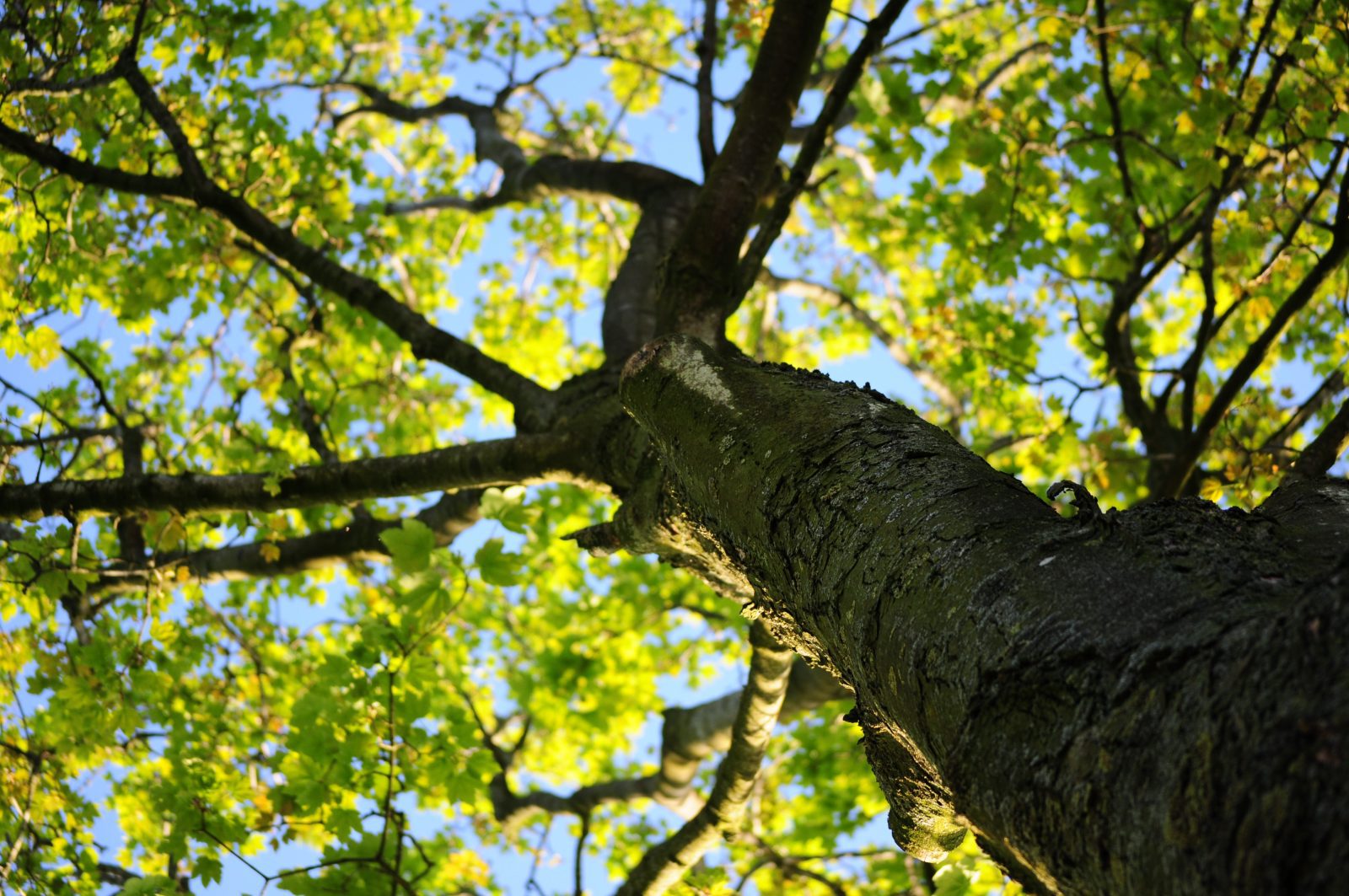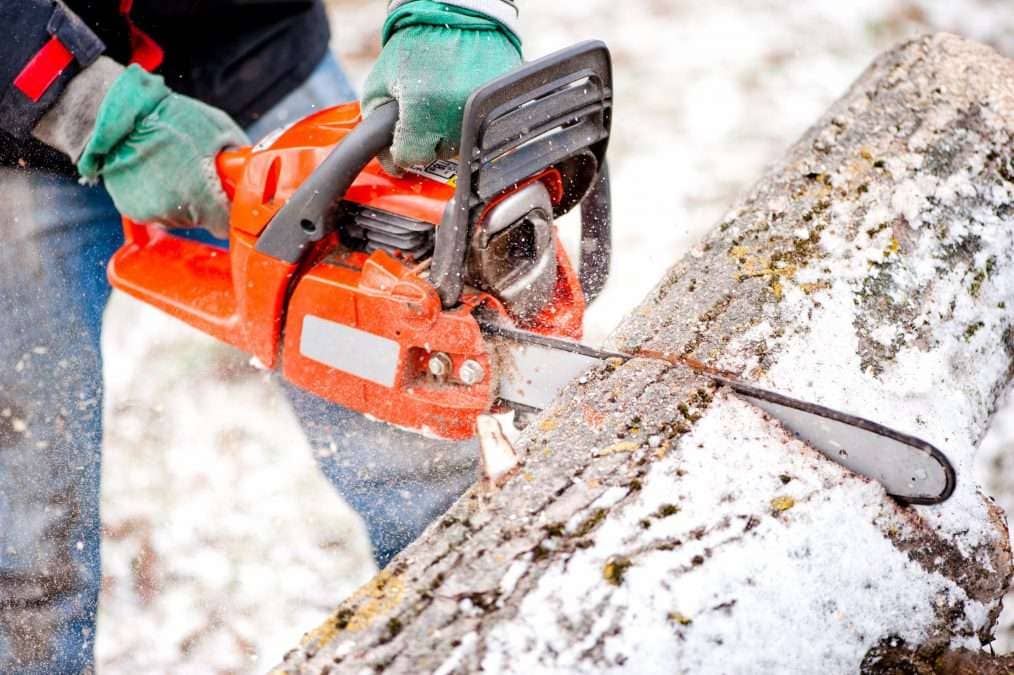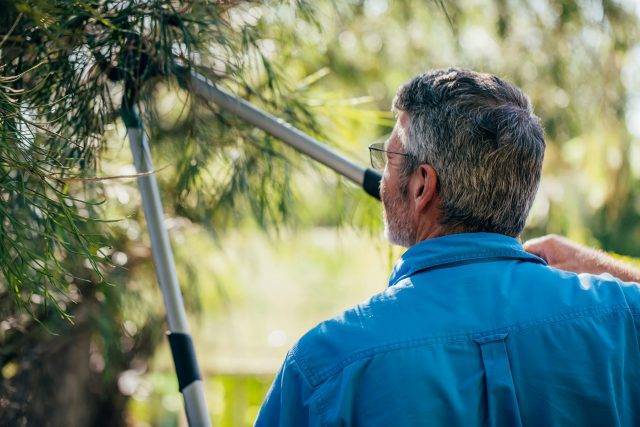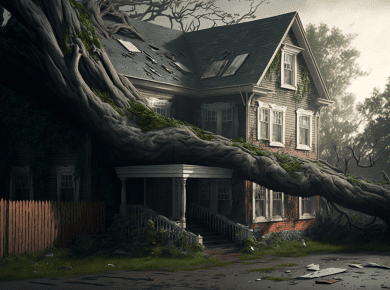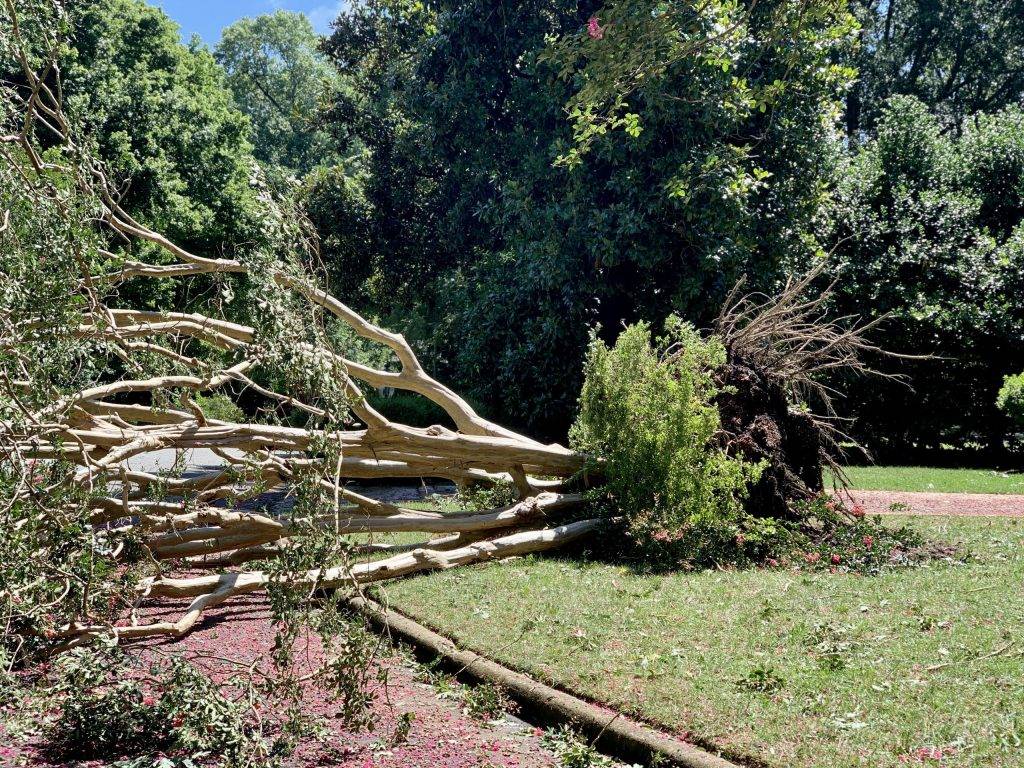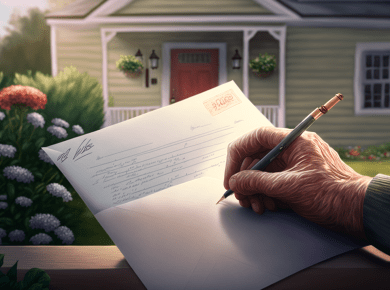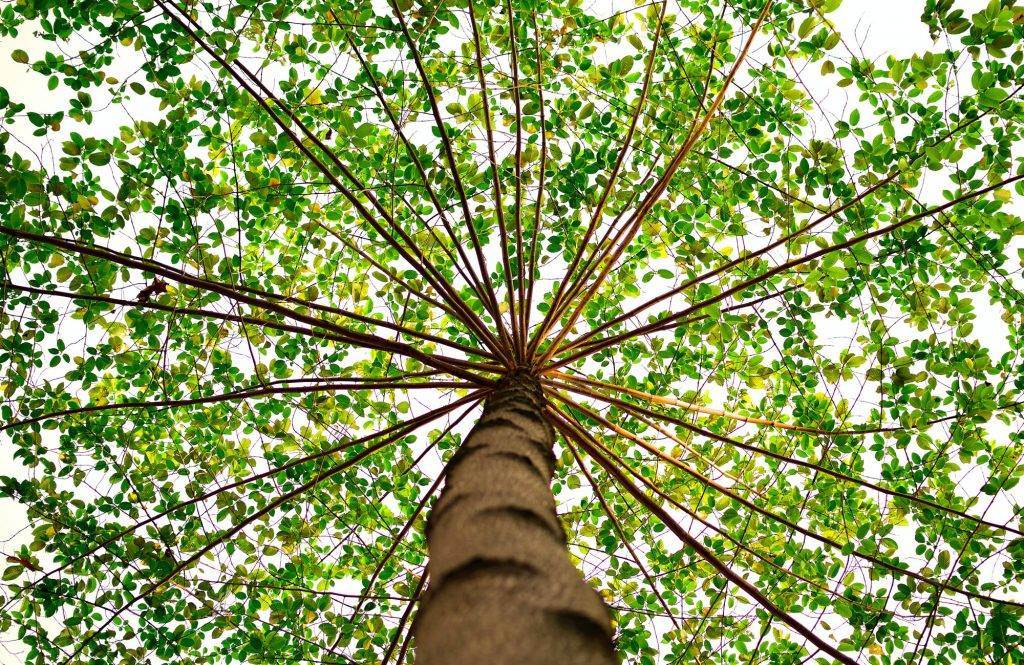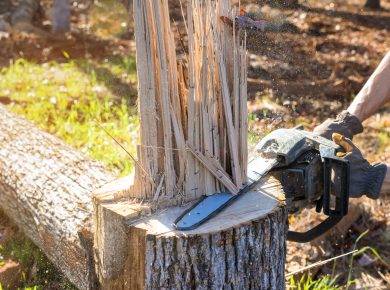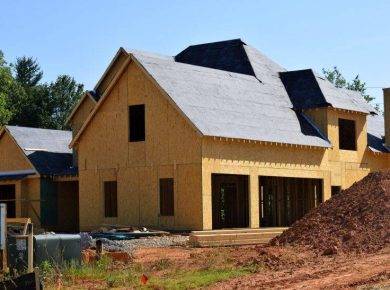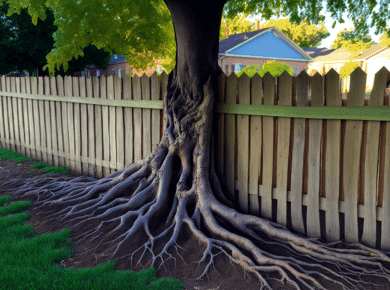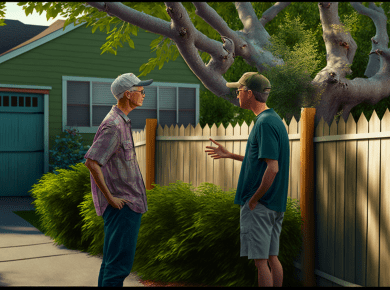Neighbors Trees Overhanging My Property: What Can You Do?
If you have a neighbor whose tree is overhanging your property, it can be a frustrating and potentially dangerous situation.
Assessing the extent of the overhang
If you have a neighbor’s tree that is overhanging your property, it is important to assess the extent of the overhang in order to determine the best course of action. The first step is to measure the distance from the trunk of the tree to the property line. This will help you determine if the tree is entirely on your neighbor’s property or if it is partially on your property.
It is also important to consider the size and type of the tree, as well as the location and condition of the overhanging branches. If the tree is large and the branches are heavy, there may be more risk of damage to your property if they fall.
Additionally, if the branches are diseased or damaged, they may be more prone to falling and causing harm. Assessing the extent of the overhang can also help you determine if the tree is a potential safety hazard and if it is necessary to take further action.
Determining the ownership of the tree
When it comes to determining the ownership of a tree that is overhanging your property, the first thing you should do is check your property lines. This can typically be done by looking at your property deed or by hiring a surveyor to mark the boundaries of your property.
If the tree is on your neighbor’s property but the branches are extending over the property line and onto your property, the tree is considered to be a boundary tree. This means that both you and your neighbor have a right to the tree and any decisions regarding its care or removal must be made jointly.
However, if the tree is entirely on your neighbor’s property and the branches are not extending onto your property, the tree is considered to be your neighbor’s tree and you do not have any legal rights to it. In this case, it is important to communicate with your neighbor and try to come to a resolution regarding the tree before taking any legal action.
If you are unable to resolve the issue with your neighbor and are concerned about the safety or damage caused by their tree, it may be necessary to seek legal action. In these cases, we recommend reaching out to a lawyer who specialized in tree disputes.
Communicating with your neighbor about the issue
If you have a neighbor’s tree that is overhanging onto your property, it is important to first assess the extent of the overhang. This can help you determine the best course of action and whether or not the tree is causing any damage to your property. Once you have assessed the situation, you will want to determine the ownership of the tree. If the tree is on your neighbor’s property, it is their responsibility to maintain it and keep it from causing damage to your property.
Communicating with your neighbor about the issue is crucial in finding a resolution. It is important to approach the conversation in a calm and rational manner, as emotions can often escalate quickly when it comes to tree issues.
You can try to work out a solution with your neighbor, such as trimming the branches or removing the tree altogether. It may also be helpful to bring in a neutral third party, such as an arborist, to assess the situation and offer recommendations.
If your neighbor is unwilling to address the issue or you are unable to come to a resolution, you may need to consider taking legal action. In these cases, we recommend reaching out to a lawyer who practices in tree disputes.
Protecting your property
In the meantime, there are steps you can take to protect your property from any potential damage caused by overhanging branches.
These may include installing a physical barrier, such as a fence or roofing material, or taking proactive measures to remove fallen branches before they cause damage.
It’s important to note that if you take any action on the tree without your neighbor’s permission, you may be opening yourself up to legal action. It’s always best to consult with an expert before taking any action.
Hiring an arborist for an evaluation of the tree
If you are unable to resolve the issue with your neighbor, or if you are concerned about the safety of the tree, it may be a good idea to hire an arborist to assess the tree. An arborist is a trained professional who can evaluate the tree’s health and recommend any necessary actions, such as pruning or removal.
This can provide valuable evidence if you need to take legal action against your neighbor.
Types of damage that a neighbor’s tree can cause
Tree branches and leaves can cause damage to your roof, clog your gutters, and create other problems. So what can you do if your neighbor’s tree is overhanging your property?
First, let’s take a look at the types of damage that a neighbor’s tree can cause when it overhangs onto your property:
- Blocked sunlight: Trees can block sunlight from reaching your property, which can be a nuisance and potentially affect the value of your home.
- Damage to roof and gutters: Overhanging branches and leaves can cause damage to your roof and gutters, leading to leaks and other issues.
- Damage to other structures: Tree branches and leaves can also cause damage to fences, sheds, and other structures on your property.
So, what can you do if your neighbor’s tree is causing problems by overhanging onto your property?
Here are some steps to consider:
- Communicate with your neighbor: It’s a good idea to try and resolve the issue with your neighbor directly. You may be able to work out a solution that involves trimming the tree or removing it altogether.
- Document the damage: If you suspect your neighbor’s tree is causing damage to your property, it’s important to document it with photos or videos. This will be useful if you need to make an insurance claim or take legal action.
- Consult with an arborist: An arborist is a trained professional who can assess the condition and growth potential of a tree. An arborist can help you understand the options for trimming or removing the tree and may be able to provide evidence for a legal case.
- Contact your insurance company: If the damage is severe and you have homeowners insurance, your policy may cover the costs of repairs. It’s a good idea to contact your insurance company as soon as possible to report the issue and inquire about coverage.
- Consult with an attorney: If you cannot resolve the issue with your neighbor or your insurance company, you may need to consider taking legal action. An attorney can help you understand your rights and options and assist you with the legal process.
If you’re dealing with a neighbor’s tree overhanging your property and need legal guidance, we recommend reaching out to us.
We can connect you with an experienced lawyer in your area who can help you navigate the legal process and fight for the compensation you deserve.
Neighbors Trees Overhanging My Property by State
When it comes to tree disputes between neighbors, it is important to understand any state-specific laws that may apply. In some states, such as California and Texas, there are laws that outline what property owners can do if a tree from their neighbor’s property is encroaching onto their own land.
In California, for example, the law states that if a tree’s branches or roots extend onto a neighboring property and are causing damage, the property owner has the right to request that the tree be trimmed back. If the tree is deemed a “public nuisance,” the property owner also has the right to remove the tree at their own expense and seek reimbursement from the neighbor.
In Texas, the law states that a property owner is not responsible for damages caused by roots or branches of a tree that naturally extend onto their neighbor’s property, unless the tree was planted with the intention of causing harm. However, if a tree’s branches or roots are causing substantial damage or are deemed a threat to safety, the property owner may have the right to request that the tree be trimmed or removed.
It is important to note that these laws may vary by state and it is always recommended to seek the guidance of an experienced lawyer in your area if you are dealing with a tree dispute with your neighbor.
We can connect you with a lawyer who practices in tree disputes to help you understand your rights and options.
In an increasingly densely populated residential area, more and more of us are experiencing situations where limbs of neighboring trees are protruding over our property boundaries. While one neighbor can enjoy the shade of a beloved old tree, another neighbor may not notice that the branches have been sticking out in the neighbor’s yard for some time. The issue has become a problem for property owners who love large, older trees, while neighbors have complained about branches overhanging their property. Sources: 4, 5, 16
If a neighbor’s tree problem interferes with your property, try to solve the problem by talking to them. If you believe that the tree or parts of a tree have fallen on your neighbor’s property, you should notify your neighbor and see if they can fix any problems. If the owner of the property has no idea that branches have enlarged the neighbor’s house, which was mentioned several times by the neighbor, and the branches eventually fall on it, he is liable for the damage, even if no branch has fallen on the neighbor’s house or his house or other valuable objects. In addition, the owner of the neighboring property is not liable for any damage caused by it, unless the neighbor’s tree falls on the house and / or other valuables on his property or the trees show obvious signs of disease or rot, as long as he has reported the danger to the city. Sources: 8, 13, 15, 18
If you want to prune the overhanging branches of the neighboring tree and do not actually need a permit, it is best to ask for permission out of respect. However, you should not go to your neighboring property without permission and should not cut down any part of the tree on your property. You may enter the adjacent property to prune or remove trees or other plants without first obtaining their consent. Felling your tree without your knowledge or consent will only lead to a neighborly dispute that may take you to court. Sources: 1, 11, 14, 17
You have legal rights when it comes to your neighbor’s tree, but the non-contentious option could lead to a better outcome. Sources: 2
A common question asked by Charleston lawyers is whether a person has the right to cut down a neighbor’s branches that hang over their property boundary. Sources: 19
The owner of the land has the right to take the law into his own hands and remove the branches of his neighbor that overhang his land. My neighbor has a hedge that is causing structural damage to my property and I have no choice but to prune the branches of the trees that grow on my property. Do I pay a tree surgeon or can I cut down the overhanging branches myself? Does my neighbor have the right to the trees I cut off from the branches and branches that hang over his property? Sources: 3, 7, 11, 18
What do I do if a tree on the side of my neighbor’s fence looks like it’s falling on my property? If I know that trees are hanging over my neighboring property, I can contact him to discuss the matter. If you know you have trees that are above your neighbor’s property Then you can approach your neighbor to talk and discuss. Sources: 7, 11
If you and your neighbor disagree about trees, what you can do depends on who owns the trees and what your local tree code says. If you disagree with your neighbors about your trees, it depends on who owns them. How can I determine my responsibility for my tree and its overhanging branches? If you know how to determine your responsibility for your tree and how it is overhanging, so that, if you know, you can find a fair solution. When I have disagreements with my neighbor about my trees Sources: 0, 12
If my tree grows right on the property boundary, I share ownership and responsibility for the tree with my neighbor. If a tree on my side of the property line is overhanging, it is my responsibility, just as trees on the other side of that line belong to my neighbors. Sources: 0, 6
If half of the trunk of the tree is on my property and the other half is on my neighbor’s side, I have to prune all the branches that hang in my garden. If I have a tree trunk together, I can cut it down and prune the branches that hang in the yard, just like any other tree. Fruit that is still on a neighbor’s tree is not a neighbor’s property, Even if the branch to which it is attached is hanging on the property. So if my neighbors have a fruit tree on our property, but it is on both sides of us, it is theirs as long as we have their consent. Sources: 9, 13, 20
If a branch of the neighboring tree extends beyond the boundary of the property, we may prune the area that hangs on our property. s property, I have no right to cut down branches beyond my boundary, but I may cut back all the limbs or branches of the tree that extend beyond the boundary of the boundary. So if my neighbor has a tree on his property that is just above the boundary of the property and causes problems, or if it just doesn’t look like it, then I can cut it down.
Cited Sources
- http://www.72tree.com/who-is-responsible-overhanging-tree-branches/ 0
- https://treecaretips.org/before-you-cut-your-neighbors-tree/uncategorized/ 1
- https://info.newjerseyattorneys.com/can-i-trim-my-neighbors-trees-and-other-property-disputes 2
- http://www.problemneighbors.co.uk/rights-trees-and-overhanging-branches.html 3
- https://www.equitylegalllp.com/california-tree-law/ 4
- http://blog.tarleyrobinson.com/?p=87 5
- https://homeguides.sfgate.com/responsibility-overhanging-tree-100592.html 6
- https://www.timesonline.com/news/20180803/ask-attorney-bernie-trees-often-cause-conflict-between-neighbors 7
- https://www.thebalancesmb.com/right-to-maintai-trees-over-your-property-line-4165795 8
- https://www.adirondacktreesurgeons.com/tree-trimming/tree-trimming-etiquette-neighbors-rights/ 9
- https://aktimber.com/dont-blow-leaves-onto-your-neighbors-property-and-other-rules/ 10
- https://www.americanarborists.net/tree-tips/2017/march/trees-and-neighbors-what-you-need-to-know/ 11
- https://www.peopleslawschool.ca/everyday-legal-problems/home-neighbors/neighbors/trees-and-neighbors 12
- https://rismedia.com/2019/09/12/what-to-do-if-your-neighbors-tree-is-encroaching-on-your-yard/ 13
- https://www.legalscoopswflre.com/real-estate/are-your-neighbors-trees-growing-on-your-property/ 14
- https://www.lamountainlawoffice.com/blog/rhode-island-tree-laws- 15
- https://www.stimmel-law.com/en/articles/encroaching-trees-who-has-right-do-what 16
- https://www.peoples-law.org/problems-neighbors-faq 17
- https://bayarborist.com/homeowner-tree-responsibility-overhanging-branches/ 18
- https://www.charlestonlaw.net/cut-neighbors-tree-limbs/ 19
- https://www.superlawyers.com/california-northern/article/when-a-tree-falls-in-california/76122a2a-0826-421b-9cc3-8de3c406aa34.html 20
